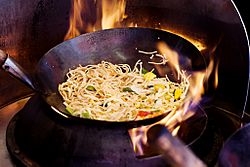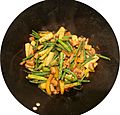Stir frying facts for kids
Stir frying is a Chinese cooking technique in which ingredients are fried in a small amount of very hot oil while being stirred in a wok. The technique originated in China and in recent centuries has spread into other parts of Asia and the West.
Scholars think that wok (or pan) frying may have been used as early as the Han dynasty (206 B.C. – 220 A.D.) for drying grain, not for cooking, but it was not until the Ming dynasty (1368–1644) that the wok reached its modern shape and allowed quick cooking in hot oil. Well into the 20th century, while restaurants and affluent families could afford the oil and fuel needed for stir fry, the most widely used cooking techniques remained boiling and steaming. Stir fry cooking came to predominate over the course of the century as more people could afford oil and fuel, and in the West spread beyond Chinese communities.
Stir frying and Chinese food have been recommended as both healthy and appealing for their skillful use of vegetables, meats, and fish which are moderate in their fat content and sauces which are not overly rich, provided calories are kept at a reasonable level.
Images for kids
-
A ginger chicken stir fry in a wok
-
During the Tang dynasty (618–907) chao referred to roasting tea leaves. Stir frying became a popular method for cooking food only later, during the Ming dynasty (1368–1644).
-
Stir frying can affect the nutritional value of vegetables. Fat content is increased because of the additional oil, and anti-oxidants are preserved better than by boiling.
See also
 In Spanish: Chao (salteado) para niños
In Spanish: Chao (salteado) para niños






